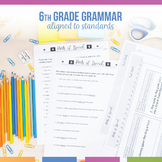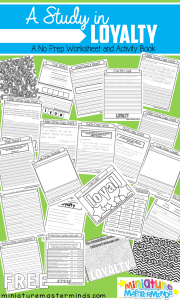Msa Practice Documentsmr. Slack's 3rd Grade Language Arts
Grade 3 Language Arts Worksheets. The third grade level is where students start to work on their reading stamina. It's good to remind them to take short breaks, when their minds wander. Third grade readers start to form a tremendous vocabulary; in fact, this is one of the largest word growth years. Take one of our many Common Core: 3rd Grade English Language Arts practice tests for a run-through of commonly asked questions. You will receive incredibly detailed scoring results at the end of your Common Core: 3rd Grade English Language Arts practice.
Msa Practice Documentsmr. Slack's 3rd Grade Language Arts Grade
Currently Perma-Bound only has suggested titles for grades K-8 in the Science and Social Studies areas. We are working on expanding this.
MS.1. The student will use word recognition and vocabulary (word meaning) skills to communicate.
1.a. The student will use word recognition skills for multi-syllabic words. (DOK 2)
1.a.1. Continue to use knowledge of vowel digraphs, diphthongs, and r-controlled letter-sound correspondences to decode unknown words.
1.a.2. Continue to use common spelling patterns to make new words (e.g., make, take, lake, cake, etc.).
1.a.3. Use inflectional endings (e.g., -s, -es, -ed, or -ing) to produce and analyze new words.

1.a.4. Create and analyze complex compound words (e.g., sky + scraper = skyscraper).
1.a.5. Create and use complex contractions (e.g., will + not = won't) correctly.
1.a.6. Read 300 to 400 high frequency and/or irregularly spelled words in connected text. (A third grader should read between 100 and 115 words correctly per minute in connected text by the end of third grade.)
1.b. The student will use syllabication types (e.g., open, closed, r-controlled, vowel team, vowel-consonant + e, consonant + le) to decode words. (DOK 1)
1.c. The student will manipulate and analyze root words and affixes (e.g., un-, re-, mis-, pre-, dis-, in-, im-, ir-, -s, - es, -ed,- ing, -y, -ly, -er, -est, -ful, -less, -able, -ness, -ish) to analyze words. (DOK 2)
1.d. The student will develop and apply knowledge of words and word meanings to communicate. (DOK 2)
1.d.1. Generate words into categories.
1.d.2. Determine relationships among words organized in categories.
1.e. The student will identify and use synonyms, antonyms, and homonyms. (DOK 1)
1.f. The student will use context to determine the meanings of unfamiliar or multiple meaning words. (DOK 2)
1.g. The student will use context to determine the simple figurative meanings (e.g., simile, metaphor, and personification) of words. (DOK 2)
1.h. The student will use reference materials to determine the meaning or pronunciation of unknown words (e.g., elementary dictionary, glossary, thesaurus, electronic dictionary, teacher or peer as a resource). [Note: These reference materials are not available during the administration of state tests.] (DOK 1)
MS.2. The student will apply strategies and skills to comprehend, respond to, interpret, or evaluate a variety of texts of increasing length, difficulty, and complexity.
2.a. The student will use text features, parts of a book, text structures, and genres to analyze text. (DOK 2)
2.a.1. Text features - titles, headings, captions, illustrations, graphs, charts, diagrams, etc.
2.a.2. Parts of a book - title page, table of contents, glossary, index, etc.
2.a.3. Text structures - sequential order, description, simple cause and effect, simple procedure, etc.
2.a.4. Genres - Fiction, nonfiction, and poetry
Ordinary differential equations solutions manual. 2.b. The student will analyze texts in order to identify, understand, infer, or synthesize information. (DOK 3)
2.b.1. Answer and generate questions about purposes for reading.
2.b.2. Answer literal and inferential questions about main characters, setting, plot, and theme.
2.b.3. Answer literal and inferential questions about characters' actions, motives, traits, and emotions.
2.b.4. Identify the stated main idea of a narrative text or the topic of an informational text.
2.b.5. Arrange in sequential order a listing of events found in narrative and/or informational text.
2.b.6. Identify cause and effect as stated in text.
2.b.7. Identify simple fact and opinion.
2.b.8. Synthesize information stated in the text with prior knowledge and experience to draw a conclusion.
2.b.9. Predict an outcome based on information stated in text and confirm or revise the prediction based upon subsequent text.
2.b.10. Use key words in text to justify prediction(s).
2.b.11. Identify important themes from texts and examine from more than one point of view.
2.c. The student will recognize or generate an appropriate summary or paraphrase of the events or ideas in text, citing text-based evidence. (DOK 2)
2.c.1. Retell a story orally and in writing including characters, setting, problem, important events, and resolution.
2.c.2. Write summaries that contain the main ideas of the reading selection and the most significant details.
2.d. The student will analyze, interpret, compare, or respond to increasingly complex literary text, literary nonfiction, and informational text, citing text-based evidence. (DOK 3)
2.d.1. Interpret text through moving, drawing, speaking, acting, or singing.
2.d.2. Make connections between self and characters, events, and information in text or among texts.
2.d.3. Compose visual images based upon text.
MS.3. The student will express, communicate, or evaluate ideas effectively.
3.a. The student will use an appropriate composing process (e.g., planning, drafting, revising, editing and publishing/sharing) to compose or edit. [Note: Editing will be tested under competency four.] (DOK 3)
3.a.1. Planning: Use a variety of graphic organizers (e.g., Venn diagrams, bubble maps, story maps, simple outlines, etc.) to generate and organize ideas.
3.a.2. Drafting: Transfer thoughts from graphic organizers and simple outlines into paragraphs.
3.a.3. Revising: Revise paragraphs for organization, to add details, and to clarify ideas.
3.a.4. Editing: Edit paragraphs using a general rubric (e.g., grammar usage, punctuation, and sentence structure). Edit for correct capitalization, punctuation, spelling and word usage.
3.a.5. Publishing/Sharing: Publish writing formally and informally using a variety of media.
Passcape software reset. 3.b. The student will compose descriptive text using specific details and vivid language. (DOK 3)
3.c. The student will compose narrative text with a clear beginning, middle, and end. (DOK 3)
3.d. The student will compose informational text and at least three supporting details. (DOK 3)
3.d.1. Reports
3.d.2. Letters, thank you notes, invitations
3.d.3. Functional texts (e.g., labels, directions, shopping lists)
3.e. The student will compose a simple persuasive text. (DOK 3)
3.f. The student will generate questions and use multiple sources to locate answers. (DOK 3)
MS.4. The student will use Standard English to communicate.
4.a. The student will use Standard English grammar to compose or edit. (DOK 1)
4.a.1. Nouns (e.g., singular, plural [including irregular forms], common, proper, possessive)
4.a.2. Verbs, helping verbs and irregular verbs
4.a.3. Verb tense (conjugation and purpose for past, present, and future)
4.a.4. Subject-verb agreement
4.a.5. Articles and coordinating conjunctions
4.a.6. Adjectives (e.g., possessive, comparative, superlative)
4.a.7. Prepositions
4.a.8. Pronouns (e.g., subject pronouns, singular pronouns, plural pronouns, singular possessive pronouns, and plural possessive pronouns)
4.a.9. Pronoun-antecedent agreement (number and gender)
4.a.10. Adverbs (avoiding double negatives)
4.a.11. Interjections
4.b. The student will use Standard English mechanics to compose or edit. (DOK 1)
4.b.1. End punctuation (e.g., period, question mark, exclamation mark, comma)
4.b.2. Periods in common abbreviations (e.g., titles of address, days of the week, months of the year)
4.b.3. Commas (e.g., dates, series, addresses, greetings, closings, quotations)
4.b.4. Quotation marks (e.g., quotations, titles of poems)
4.b.5. Underlining/ Italics (titles of books and movies)
4.b.6. Apostrophes (e.g., contractions; possessives)
4.b.7. Colons (in notation of time)
4.b.8. Capitalization (e.g., first word in a sentence, proper nouns, days of the week, months of the year, holidays, titles, initials, the pronoun 'I')
4.b.9. Spell words commonly found in third grade level text.
4.b.10. Write legibly.
4.c. The student will use correct and varied sentence structures. (DOK 2)
4.c.1. Analyze sentences to determine purpose (e.g., declarative, interrogative, exclamatory, imperative).
4.c.2. Compose simple sentences with compound subjects and/or compound predicates; compound sentences.
4.c.3. Avoid sentence fragments and run-on sentences.
Msa Practice Documents Mr. Slack's 3rd Grade Language Arts Lesson Plans
3rd Grade Language Skills Assessment
Questions from 12 different 3rd Grade Language Arts topics
1. Pick the best answer.
That's the ____________ Halloween costume ever!
scary scarier scariest
2. Write the two smaller words that make up the compound word.
bedroom ______ ______
What's a compound word that means:
a ball made of snow ______________
3. Pick the best connecting word.
The lobster was caught in the trap, _________ it was not hurt.
after but
4. Add the correct end punctuation: . ? or !
Call an ambulance now__
5. Pick the correct word.
He was stung by a _________. bee be
6. Complete the sentence by adding the past tense.
Do you know what he ____________ yesterday? find
Write the past tense for these words:
drop _______ rob _______ hum _______
7. Complete the sentence by writing in the missing possessive pronoun.
The books belong to the students. They are __________ books.
8. Fill in the missing prefix or suffix.
not usual: ____usual
with or full of hope: hope_____
9. Pick the right pronoun.
One of the boys lost _______ hat. his their
10. Write the plural for these words:
Msa Practice Documentsmr. Slack's 3rd Grade Language Arts Worksheets
box _______ key _______ city _______
11. Pick the correct verb.
Craters _______ much of the moon. covers cover
12. Break these words into syllables.
review basketball environment

1. scariest 2. bed room, snowball 3. but 4. ! 5. bee 6. found; dropped, robbed, hummed 7. their 8. unusual, hopeful 9. his 10. boxes, keys, cities 11. cover 12. re/view, bas/ket/ball, en/vi/ron/ment

